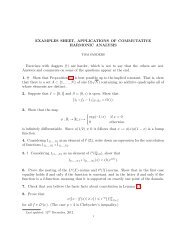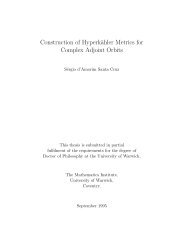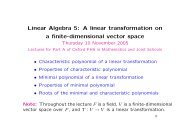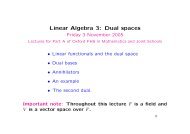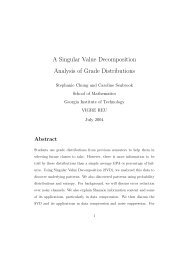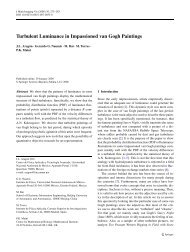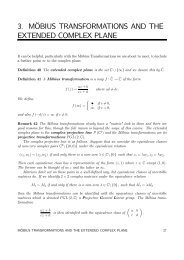Fourier Series and Partial Differential Equations Lecture Notes
Fourier Series and Partial Differential Equations Lecture Notes
Fourier Series and Partial Differential Equations Lecture Notes
You also want an ePaper? Increase the reach of your titles
YUMPU automatically turns print PDFs into web optimized ePapers that Google loves.
Chapter 5. Laplace’s equation in the plane 58<br />
Thus if the new data (F,G) are close to the original data (f,g) in the sense that<br />
|F(x)−f(x)| < ǫ<br />
1+T<br />
<strong>and</strong> |G(x)−g(x)| < ǫ<br />
1+T<br />
then the corresponding solutions are close together in the sense that<br />
for −∞ < x < ∞, (5.103)<br />
|Y(x,t)−y(x,t)| < ǫ for −∞ < x < ∞ <strong>and</strong> 0 < t < T. (5.104)<br />
In this sense 3. holds <strong>and</strong> the IVP is well-posed.<br />
Example 5.9 BycontrastthecorrespondingIVPforLaplace’s equation isnot well-posed.<br />
If y(x,t) = 0, f(x) = 0, g(x) = 0 then y is a solution of the IVP<br />
If<br />
Y(x,t) = δ 2 cos<br />
∂2y ∂x2 + ∂2y = 0, −∞ < x < ∞, t > 0, (5.105)<br />
∂t2 y(x,0) = f(x),<br />
<br />
x<br />
<br />
sinh<br />
δ<br />
Then Y(x,t) is a solution of the IVP<br />
∂y<br />
(x,0) = 0, −∞ < x < ∞. (5.106)<br />
∂t<br />
<br />
t<br />
, F(x) = 0, G(x) = δcos<br />
δ<br />
<br />
x<br />
<br />
, (5.107)<br />
δ<br />
∂2Y ∂x2 + ∂2Y = 0, −∞ < x < ∞, t > 0, (5.108)<br />
∂t2 Y(x,0) = F(x),<br />
∂Y<br />
(x,0) = G(x), −∞ < x < ∞.<br />
∂t<br />
(5.109)<br />
Again suppose we want to make predictions in 0 < t < T. Then<br />
<br />
x<br />
<br />
<br />
|F(x)−f(x)| = 0 < δ, |G(x)−g(x)| = δcos<br />
< δ,<br />
δ<br />
(5.110)<br />
<strong>and</strong><br />
But<br />
<strong>and</strong> we cannot make<br />
by making δ suitably small.<br />
|Y(0,T)−y(0,t)| = δ 2 sinh<br />
<br />
t<br />
< δ<br />
δ<br />
2 <br />
T<br />
sinh . (5.111)<br />
δ<br />
δ 2 <br />
T<br />
sinh =<br />
δ<br />
1<br />
2 δ2e<br />
T/δ −e −T/δ<br />
→ ∞ as δ → 0, (5.112)<br />
|Y(0,t)−y(0,t)| < ǫ for 0 < t < T, (5.113)




